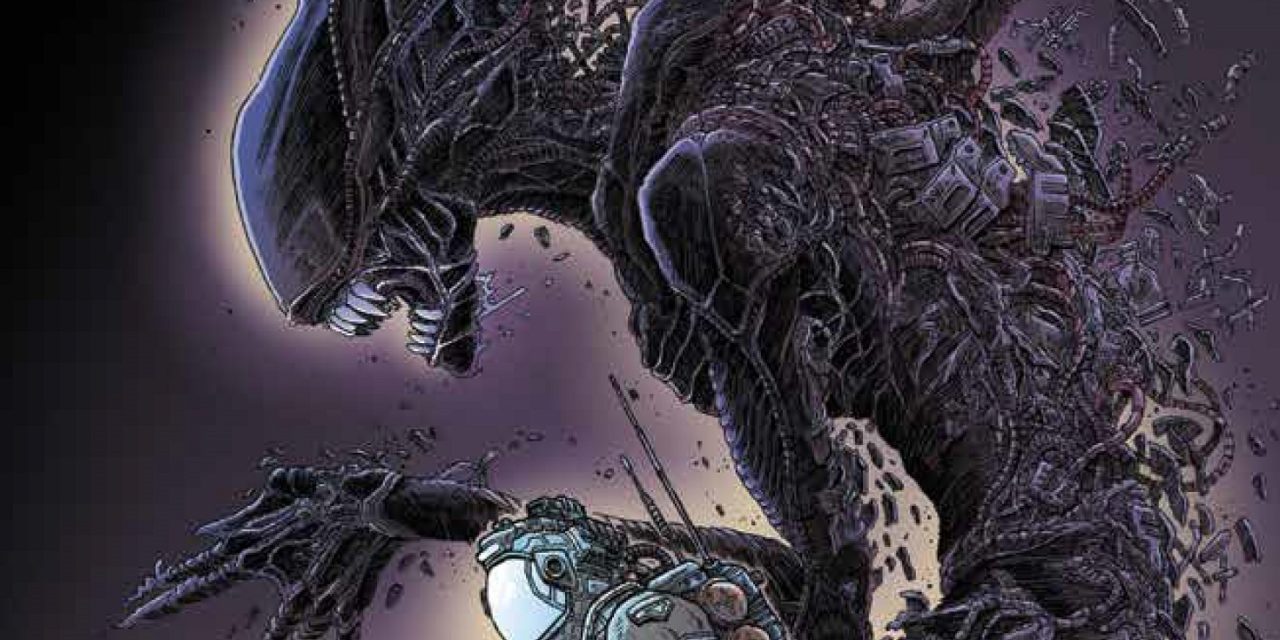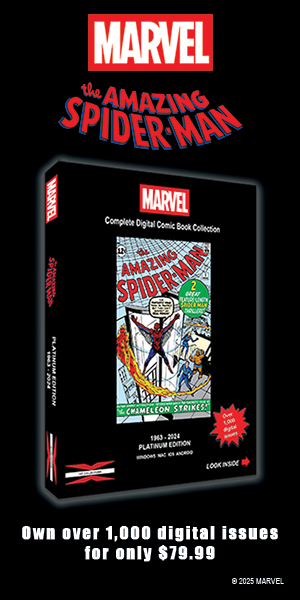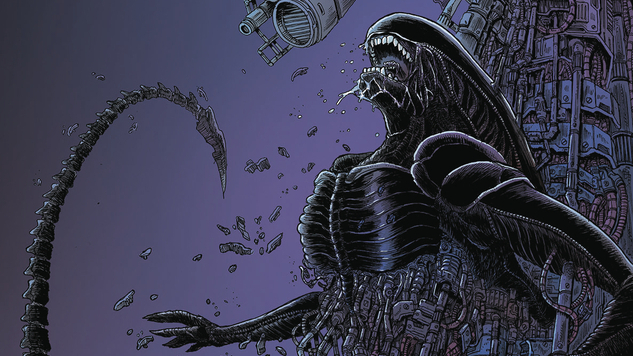In the vast cold of space lurks a terrifying evil that knows no mercy. And soon, that evil will be inside you.
In James Stokoe’s Aliens: Dead Orbit, a four-issue miniseries from 2017, the xenomorph, first brought to the screen in Ridley Scott’s 1979 masterpiece, returned in a lean, tense, modern comic book take that revived a well-known franchise. At least, for the few years it was available in print.
Dead Orbit, widely praised on release, proved to be one of the final Dark Horse Aliens comics before Disney’s purchase of 20th Century Fox and their recent restart of the franchise under Marvel. That switch didn’t just stop new comics being released under Dark Horse, it stopped the reprinting of all previously published Aliens series. Right now, Marvel is slowly rereleasing the original Aliens comics from Dark Horse in new collections, but Dead Orbit remains lost, caught in the void between publishers, even though it stands as one of the best interpretations of the essential terror of the franchise.
I’ve previously examined Stokoe’s “Godzilla: Half-Century War” and how the author was able to create a more personal spin on the kaiju madness of the Godzilla films. And while “Half-Century War” isn’t a horror story like “Dead Orbit,” it does traffic in the same ideas of a single person encountering a creature beyond their understanding and being warped by its effect on their mind.
In “Dead Orbit,” we follow engineering officer Waczelewski, part of a small crew on a secluded space waystation that soon comes into contact with a broken down spaceship and its cryogenically frozen crew. While we never learn their background, it’s clear these space smugglers have been impregnated by xenomorphs and before long, the aliens wreak havoc on the quickly disintegrating space station.
The following comic is a perfect encapsulation of terror on the comic book page and a lesson in how to interpret film horror into another medium. And now, only a few years later, Aliens: Dead Orbit stands as a lost horror masterpiece.
The Horror of Alien
The Alien franchise has, over the decades, grown to be a behemoth. While the continued Alien film sequels have seen their highs and lows, the Fox (now Disney) franchise has been given life in every other medium, including video games, books, and comic books starting in 1988 at Dark Horse Comics. Along with Predator, countless Dark Horse miniseries have given continued life to the Alien franchise, with writers and artists putting their own spins on the horror of the xenomorph with every new entry. Some are darkly horrifying, others are fun adventures, but every single one faces the same challenge – how do you captivate and terrify an audience that has already seen every scare on the big screen?
There’s something about the Xenomorph that has repulsed and captivated audiences ever since it first slithered on screen, pulled from the mind of H.R. Giger. While the first several films in the franchise drew their horror from the sexual terror of the Xenomorph, the sheer amount of Alien stories has led to the Xenomorph being reinterpreted for a wide variety of fears.
The xenomorph is inherently unknowable, playing on a fear of the unknown found in unexplored space and then violently, violatingly being moved into a fear of the unknown found within our own bodies. There’s lots of room for interpretation here, which we can see in the shift from the sexual terror of Scott’s original film to the buglike hive horror of Cameron’s sequel, but the alien is always at its scariest when it’s unknowable.
So it stands to reason that with each successive story, the xenomorph becomes a little more known and a little less scary. And this is why almost every Aliens comic stars a new cast of characters coming into contact with the creatures for the first time. Although the audience may know what’s in store, the main characters do not and we can then vicariously share their fear.
Dark Horse’s Alien comics typically break down into three categories – random space workers encounter an alien outbreak, nefarious scientists try to control the xenomorph for their own purposes, and space marines do battle with a legion of creatures. And of course there’s the comics that mix and match.
These story styles also find their roots in the DNA of the Alien franchise established on film, because this has always been about more than simply man vs space terror. The alien unknown is also found in the android populating every film, who may or may not play a part in any given comic, and corporate greed that seeks to control, weaponize, and profit from an uncontrollable, elemental force of death, usually in the form of the Weyland-Yutani Corporation. The amount each of these elements plays within a story is up to each creative team.
The first Alien comic ever published was Heavy Metal’s adaptation of the Ridley Scott film in 1979, known as “Alien: The Illustrated Story,” written by Archie Goodwin and illustrated by Walt Simonson. And for a brutal sci-fi story with European influences, Heavy Metal is the perfect publisher. But it would be another decade until Alien would be brought to life in comic books again, now given the potential for franchising after James Cameron’s sequel was a box office success. The first Aliens comic published at Dark Horse was “Aliens: Outbreak,” originally published as simply “Aliens” from 1988 to 1989, and starring Newt and Hicks as a direct sequel to Cameron’s film. It’s an indicator of the publisher’s focus in these comics: the action horror of the sequel instead of the space-set slasher of the original.
Cue many, many, many Aliens comics and the original Aliens vs Predator stories, which takes us all the way to Dead Orbit decades later.
But despite its title taking after the sequel, Stokoe’s Dead Orbit is far more in line with Ridley Scott’s original.
The Terror of Dead Orbit
Horror is difficult to accomplish on the comic book page. Horror films create their own pacing and benefit from musical scores and sudden scares to frighten the audience, who are passive in their experience and are simply taken along for the ride. Novels reveal horror sentence by sentence, allowing the plot to unfold in the imagination of the reader to create something terrifying. But comic books must attempt to wrangle the attention and reading flow of the audience through a static visual medium.
For the closest approximation to jump scares, horror comics must rely on the page turn, hoping that readers haven’t skipped ahead or that a poor layout hasn’t spoiled the reveal hidden on the other side of the page. But atmosphere and tension must occur in the grey middle ground that happens between the art laid down on the page and the life being given to said page by the reader.
Stokoe’s art is heavily influenced by manga. Tons of hand drawn details and an exaggerated usage of motion lines that are used for both speed and to illustrate the intensity of an emotion. The sheer amount of detail crammed into every page could be overwhelming, but Stokoe has a strong grasp on where to place the reader’s eyes and how to guide them from panel to panel. For a story about an old, crummy, disintegrating space station, it’s perfect. And when it’s used to bring the story’s usage of signature xenomorph gore, it’s horrifying, but also slightly cartoonish, which keeps it from being too nauseating. Still, the hyper detail pushes us to examine something like the chest burst up close, imprinting the horror of the moment on our minds, maybe even more so than Scott’s original. Stokoe’s detailed, heavily-lined, lumpy characters convey the pain, stress, and terror that anyone would feel in this situation. And alongside them, the corrupted organic terror of the drooling, clawing xenomorph.
And Dead Orbit is completely Stokoe’s baby. Written by him. Lettered by hand. Penciled and inked by him on paper. And colored by him in Photoshop, with the creator leaning heavily into gradients that, even when using darker colors, pop with vibrant choices.
One of the strengths of “Dead Orbit” is that it trusts its readers to have a preexisting understanding of its monster’s nature and rules and skips all unnecessary explanation to cut straight to the meat of its story. This means our survivors have no clue why this is all happening or what they can do to survive, while the audience experiences a sort of dramatic irony in knowing the ins and outs of the xenomorph simply by having previous experience with this franchise.
Stokoe, who had originally pitched an action-heavy Aliens comic to Dark Horse with a focus on a group of space marines, said, “Like anything, I think the xenomorphs a’re creepier the less you know about them. I love most of the sequels and other stories, but they do tend to demystify them a lot, which takes away from the horror.”
Dead Orbit’s story is extremely simple, almost to a fault. Pick up distressed ship, aliens unleashed, crew picked off one by one. And its characters have very little backstory. We don’t get to learn much about them because this is a story about survival. We know their motivation: survive. And that’s about it. If Stokoe’s pacing and sense of horror wasn’t this strong, that would be a major shortcoming. Instead, the often wordless storytelling is our focus and not anything else.
But to keep the story fresh, Stokoe splits the narrative into 2 timelines, opening with Waczelewski as the only surviving crew member and then flashing back to what happened. The comic jumps back and forth between the time periods. Past Waczelewski and crew witness the birth of 2 xenomorphs, are slowly picked off, and experience the space station falling apart, sending it into a dead orbit around a nearby planet. Present Waczelewski, now the only survivor, is forced out of the only safe spot on the station when the oxygen supply begins to run low, now completely rattled by the deadly creatures and desperate to survive.
As the comic reaches its climax, the two timelines converge, with Stokoe no longer keeping them separated into their own pages, but overlapping them within the panel and using color differentiations (blue and purple vs red and orange) to distinguish the periods. The result is that our lead character’s past trauma and current desperation blend into one while the pace becomes frantic. In addition, Stokoe’s use of repeated sounds like bones breaking or dying gasps for breath transcend the boundaries between time periods and illustrate how haunted Waczelwski is by what he’s experienced.
Seen in a chronological order and it isn’t much different from the original Alien, but then again, neither is Cameron’s sequel. It’s Stokoe’s split timeline that helps keep his story fresh and put readers on edge.
It’s difficult to actually spoil a comic as elemental as Dead Orbit, but it’s sense of dread is propelled by knowing where this story will inevitably lead, but also in hoping that it will lead somewhere else. Really, the best way to enjoy a comic as light on story as this is to let the pages breathe and have their pace match the reality of the actions you see. Stokoe rarely uses splash pages, but when he does, it’s to illustrate the comic’s greatest reveals, scares, and moments of body horror. Take these in, explore the details, and let the horror envelop you. Likewise, Stokoe’s extreme differentiation between sizes of speech bubbles illustrate the fear and intensity of each character. Comics don’t come with sound design, but these take its place.
A comic this simple and well paced is designed to be a thrill ride that sends us spiraling through the world of the xenomorph until its final page. Only able to breathe once we’re finished, safely back in our own world and freed from the horrors of a hungry space.
At the time of this video’s publication, Marvel has begun publishing their first Alien series after acquiring the rights to the franchise. And while there’s been no reveal of the xenomorphs crossing over with the publisher’s main superhero universe yet, it’s only a matter of time. But for now, Marvel will have to contend with the same challenges that Dark Horse faced for years in trying to make fresh and scary stories that both leverage and counteract the familiarity of an iconic franchise.
Whether they succeed will depend on the talents and perspective of each creative team. But until some point in the future, Dead Orbit will remain waiting in the cold, lonely vacuum of space, until it’s found once again.
https://www.cbr.com/exclusive-james-stokoe-is-eager-to-giger-with-aliens-dead-orbit/




Leave a Reply